Education: Themes
Like the science of Aquarius, our educational resources fall into general themes of salinity, water cycle, ocean circulation
and climate. The thematic resources listed below - from basic to advanced - include hands-on activities, online activities,
movies, podcasts, frequently asked questions (FAQs), and articles. Each resource is tied to specific
student outcomes, which are aligned with National Science Education Standards, North American
Association for Environmental Education guidelines, and Ocean Literacy standards.
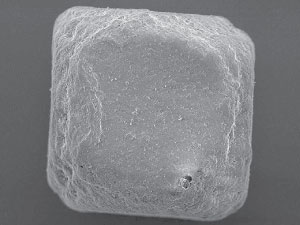 A defining characteristic of ocean water is its relatively high concentration of dissolved salts or salinity. The
concept maps, activities and videos in this section focus on relationships between salt and water, including water properties,
phases, heat capacity and the hydrologic cycle.
A defining characteristic of ocean water is its relatively high concentration of dissolved salts or salinity. The
concept maps, activities and videos in this section focus on relationships between salt and water, including water properties,
phases, heat capacity and the hydrologic cycle.
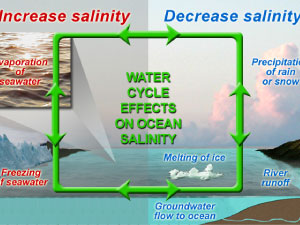 Ocean surface salinity is a key tracer for understanding the freshwater fluxes into and out of the ocean system.
With Aquarius data, scientists are able to relate salinity variations to evaporation and precipitation, providing insight
into how the ocean responds to seasonal and annual changes in the water cycle.
Ocean surface salinity is a key tracer for understanding the freshwater fluxes into and out of the ocean system.
With Aquarius data, scientists are able to relate salinity variations to evaporation and precipitation, providing insight
into how the ocean responds to seasonal and annual changes in the water cycle.
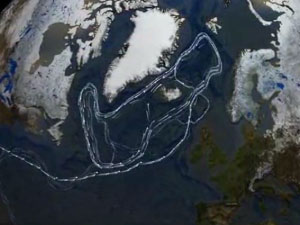 With temperature, salinity determines seawater density and buoyancy, driving the extent of ocean stratification, mixing and
water mass formation. Aquarius is highly complementary to existing satellite programs that monitor sea surface temperature
because, together, salinity and temperature control density at the ocean surface.
With temperature, salinity determines seawater density and buoyancy, driving the extent of ocean stratification, mixing and
water mass formation. Aquarius is highly complementary to existing satellite programs that monitor sea surface temperature
because, together, salinity and temperature control density at the ocean surface.
 Aquarius measures ocean surface salinity, a climate-sensitive variable that - along with satellites that measure ocean
currents, sea surface temperature, winds, and ocean color - helps scientists study how global ocean circulation responds
to climate change. Why salinity? Changes in ocean saltiness can affect the density of water and play a major role in ocean
circulation.
Aquarius measures ocean surface salinity, a climate-sensitive variable that - along with satellites that measure ocean
currents, sea surface temperature, winds, and ocean color - helps scientists study how global ocean circulation responds
to climate change. Why salinity? Changes in ocean saltiness can affect the density of water and play a major role in ocean
circulation.
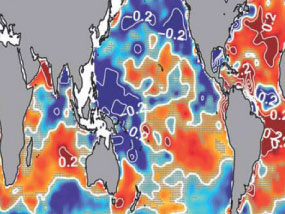 Studies suggest that seawater is becoming fresher in high latitudes and tropical areas dominated by rain, while in sub-tropical
high evaporation regions, waters are getting saltier. This pattern appears to be related to changes in evaporation,
precipitation, and ocean circulation in what some scientists call an "accelerated" water cycle.
Studies suggest that seawater is becoming fresher in high latitudes and tropical areas dominated by rain, while in sub-tropical
high evaporation regions, waters are getting saltier. This pattern appears to be related to changes in evaporation,
precipitation, and ocean circulation in what some scientists call an "accelerated" water cycle.
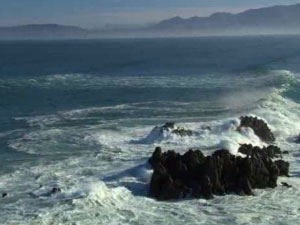 Carbon is the basic building block of life, and its compounds form solids, liquids, or gases. The ocean plays the most
critical role in regulating Earth's carbon balance, and understanding how the carbon cycle is changing is key to
understanding Earth's changing climate.
Carbon is the basic building block of life, and its compounds form solids, liquids, or gases. The ocean plays the most
critical role in regulating Earth's carbon balance, and understanding how the carbon cycle is changing is key to
understanding Earth's changing climate.
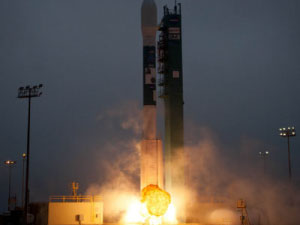 The Aquarius/SAC-D mission is a collaboration between NASA and Argentina's space agency, Comisión Nacional de Actividades
Espaciales. NASA's Aquarius instrument provided global-scale salinity data critical to our understanding of the
water cycle, ocean circulation, and climate from late August 2011 until June 8, 2015.
The Aquarius/SAC-D mission is a collaboration between NASA and Argentina's space agency, Comisión Nacional de Actividades
Espaciales. NASA's Aquarius instrument provided global-scale salinity data critical to our understanding of the
water cycle, ocean circulation, and climate from late August 2011 until June 8, 2015.







